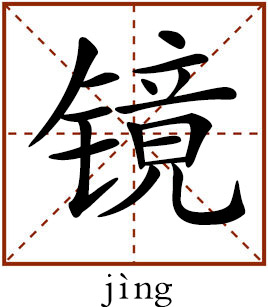Mirror

This character refers to mirrors. Bronze mirrors, which precede the glass mirrors of today, are loaded with profound historical and cultural connotations. A good example of the culture of mirrors can be found in the words of Emperor Taizong of Tang—“By using bronze as a mirror one can set one’s clothing straight; by using the ancients as a mirror one can know about rise and fall; by using others as a mirror one can understand success and failure.”
照花前后镜
zhào huā qián hòu jìng
Zhao means “look in” and hua refers to flower. Qian and hou mean “front” and “back” while jing is known as a mirror. This term depicts a woman looking into a mirror while decorating her hair with flowers.
This is a line from a ci poem by the Tang poet Wen Tingyun (c. 812–866). The poem, which is one of the series of the poems “To the Tune of Pusaman,” depicts how a woman makes herself up after she wakes up in the morning. “Hills upon hills in light or dim aura glow;/ Her cloudy hair sweeps o’er her cheeks like snow./ Painting her brows, she feels listless;/ Combing, washing, all tardiness./ She mirrors herself to and fro;/ Her face, a rose? She blurs the two./ She strokes a broidered coat with a sigh,/ Where a pair of partridges fly” (trans. Zhao Yanchun).
There are several guesses about the “hills” in the first line. Some believe that the hills refer to the images on a screen in the lady’s bedroom, shimmering in the sunlight. Another guess associates it with the hill-shaped eyebrow popular during the Tang Dynasty. The whole poem seems to be merely a depiction of a lady applying make up to herself in a blase fashion. However, the last two lines—her sigh as she strokes a coat embroidered with a pair of partridges—reveal her melancholy in being alone. Wen was regarded as the first truly distinctive writer of ci poetry, which flourished in the subsequent Song Dynasty. He was admired for the delicate sensuality of his verse and his skill at evoking feminine sensibility. The solitary women and their hidden desires in his poems have continuously fueled the inspiration of later generations. Wen was chosen as the lead poet in the first major anthology of ci poetry, the Huajian Ji (Among the Flowers), compiled by Zhao Chongzuo in 940 to popularize the new genre.
edited by JIANG HONG
